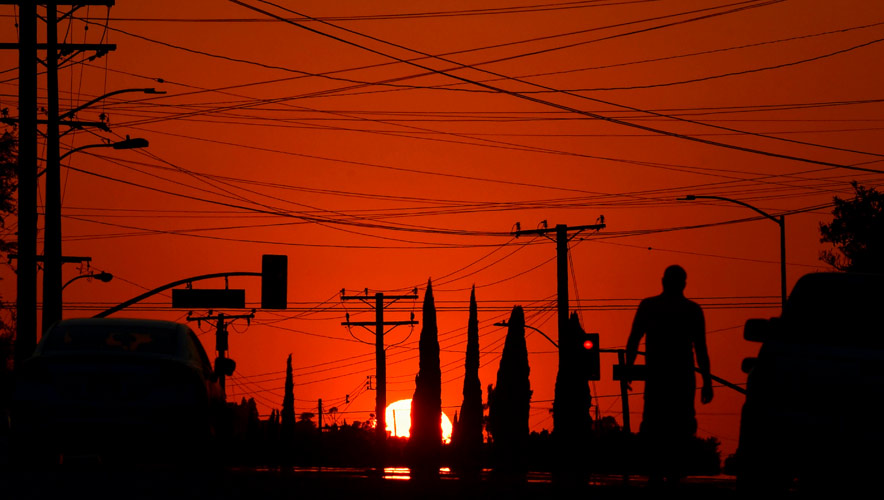'Heat Dome' Threatens Millions with Extreme Temperatures This Weekend
Weather experts are warning that people living in the Southwest United States will be subject to dangerous, perhaps even deadly, temperatures this weekend, climbing well into triple digits.
“Nearly 38 million people from California to South Texas are under some sort of heat-related alert through at least part of the weekend,” the New York Times reported. “A heat wave is defined as a period of abnormally and uncomfortably hot and unusually humid weather that lasts for two or more days.”
Forecasters are saying that a “heat dome”—a high-pressure area associated with this spike in temperatures—will cycle any escaping radiation or heat back to the ground, adding to the heat from the sun’s rays.
Heat warnings for states in the area—including Arizona, California, Nevada, and parts of New Mexico, Utah, and Texas—are already in effect, slated to last through either Saturday or Sunday. “More than 50 daily high-temperature records could be broken through the weekend—including in Death Valley, California, one of the hottest places on earth,” CNN reported. “…Death Valley is forecast to reach 121 on Friday. If it does, that will break the daily record of 120 set back in 1994.”
With hotter temperatures expected into the weekend, the HeatRisk will be on the high/very high side. This means that most if not all of the general population is at risk for heat-related illness if proper heat precautions are not taken. Please protect yourself! #azwx #cawx pic.twitter.com/AyZPhSD47u
— NWS Phoenix (@NWSPhoenix) June 8, 2022
For parts of the mid-Atlantic, unaccustomed to prolonged periods of extreme heat, air conditioning to battle the heat is becoming an increasing concern for homes, businesses, and schools. The Washington Post reported last week that urban schools in Philadelphia, Pennsylvania, and Baltimore, Maryland, sent students home early. The lack of ventilation in older buildings combined with regional temperatures and humidity simply makes classrooms too hot.
And that heat, regardless of the region, can turn deadly. “Extreme heat is the leading weather-related killer in the United States, and the first such event of the season can be particularly dangerous since people are not yet accustomed to such high temperatures,” Axios reported.
Exacerbating this summer’s heat is that the U.S. National Oceanic and Atmospheric Administrion (NOAA) also predicted that the majority of the West will have below-normal precipitation, failing to bring some respite from a regional record-setting drought that has persisted in the area.
Near record high temps are possible Friday. There will be widespread areas of High Heat Risk in the Valley on Friday, so avoid outdoor activities during the warmest hours of the day and stay hydrated. This heat will impact everyone, not just those sensitive to heat risk! #CAwx pic.twitter.com/BT3KGDMOHp
— NWS Sacramento (@NWSSacramento) June 5, 2022
But beyond this weekend, that mercury isn’t expected to slip too far back down the thermometer this season. In May, NOAA issued predictions that the summer season will experience above-normal temperatures for the 48 continental U.S. states, with a few exceptions.
This same heat, according to energy experts, could result in power outages.
In May, the North American Electric Reliability Corporation (NERC) warned that several areas of the continent “are at elevated or high risk of energy shortfalls this summer” because of the anticipated high temperatures and drought. As more and more people crank up their air conditioning units to try to battle the heat, these peaks in energy demand could also trigger forced power outages as grids try to maintain balance and service for their customers.
Although NERC estimates that the majority of North America will have sufficient energy, it cautioned that “the Western Interconnection, Texas, Southwest Power Pool (SPP), and Saskatchewan are at ‘elevated risk’ of energy emergencies during extreme conditions.” The U.S. Federal Energy Regulatory Commission echoed these warnings, noting “extreme operating conditions” could stress operations in the energy supply sector.
“Active late-summer wildfire season in Western United States and Canada is anticipated, posing some risk to bulk power system reliability,” NERC added.
North America is not the only region looking at a cruel summer.
Parts of India and Pakistan have been under a heat wave since March, with temperatures in triple-digit territory. The weather has been so extreme for so long that humans aren’t the only ones being sent to the hospital—heat stroke is for the birds, too.
During hot weather, your body's ability to cool itself is challenged in ways you may not expect. Stay #WeatherReady by learning the symptoms of excessive heat exposure and the appropriate responses.https://t.co/KMzAM23na8 pic.twitter.com/sSdujnNj56
— NWS San Diego (@NWSSanDiego) June 7, 2022
“One hospital in the Indian city of Gurgaon said it had treated a record number of birds for conditions such as fever, dehydration, and heatstroke as temperatures rose to over 46 degrees Celsius (114.8 F) this week,” Vice reported in May.
Besides both human and avian casualties, India is also seeing impacts elsewhere, including education as students are sent home early, lower productivity as businesses change work schedules, and fewer crops as “the heat kept some farmers inside and stunted harvests,” the Times reported.
India’s Meteorological Department said on 9 June that the intense heat is expected to linger until at least 15 June.
Parts of Europe are seeing the impacts of the above-normal heat.
In Italy, the Ministry of Health issued a heat warning for Perugia, Rome, and three other cities, cautioning that there could be negative physical effects from the heat.
A heatwave in Spain is expected to feature temperatures above 40 degrees Celsius (104 F). “It will be the joint earliest heatwave since records began, tied with a heatwave that started on 11 June 1981,” The Guardian reported.
Neighboring Portugal was not spared, as almost the entire country experienced a “severe drought at the end of May,” according to ABC News. That month ended up being the hottest the country had had in the past 92 years.
